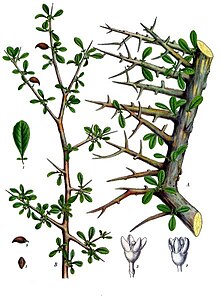| Commiphora myrrha | |
|---|---|

| |
| Scientific classification | |
| Kingdom: | Plantae |
| Clade: | Tracheophytes |
| Clade: | Angiosperms |
| Clade: | Eudicots |
| Clade: | Rosids |
| Order: | Sapindales |
| Family: | Burseraceae |
| Genus: | Commiphora |
| Species: | C. myrrha
|
| Binomial name | |
| Commiphora myrrha | |
| Synonyms[2] | |
|
List
| |
Commiphora myrrha, called myrrh,[1] African myrrh,[1] herabol myrrh,[1] Somali myrrhor,[1] common myrrh,[3] is a tree in the family Burseraceae. It is one of the primary trees used in the production of myrrh, a resin made from dried tree sap. The tree is native to the Arabian Peninsula (Oman, Yemen) and to Africa (Djibouti, Ethiopia, Somalia, Northeast Kenya).[4] It is called 'mur' (المر) in Arabic, meaning bitter. It famously comes from Mecca, so it is called 'Mur Makki'.[citation needed]
- ^ a b c d e "Commiphora myrrha". Germplasm Resources Information Network. Agricultural Research Service, United States Department of Agriculture. Retrieved 2009-01-15.
- ^ "Commiphora myrrha". The Plant List: A Working List of All Plant Species. Retrieved June 6, 2014.
- ^ Kynes S (8 November 2013). Mixing Essential Oils for Magic: Aromatic Alchemy for Personal Blends. Llewellyn Worldwide. pp. 191–. ISBN 978-0-7387-3715-7.
- ^ "Commiphora myrrha". Cactus art: The world of cacti & succulents. Retrieved 2009-01-15.